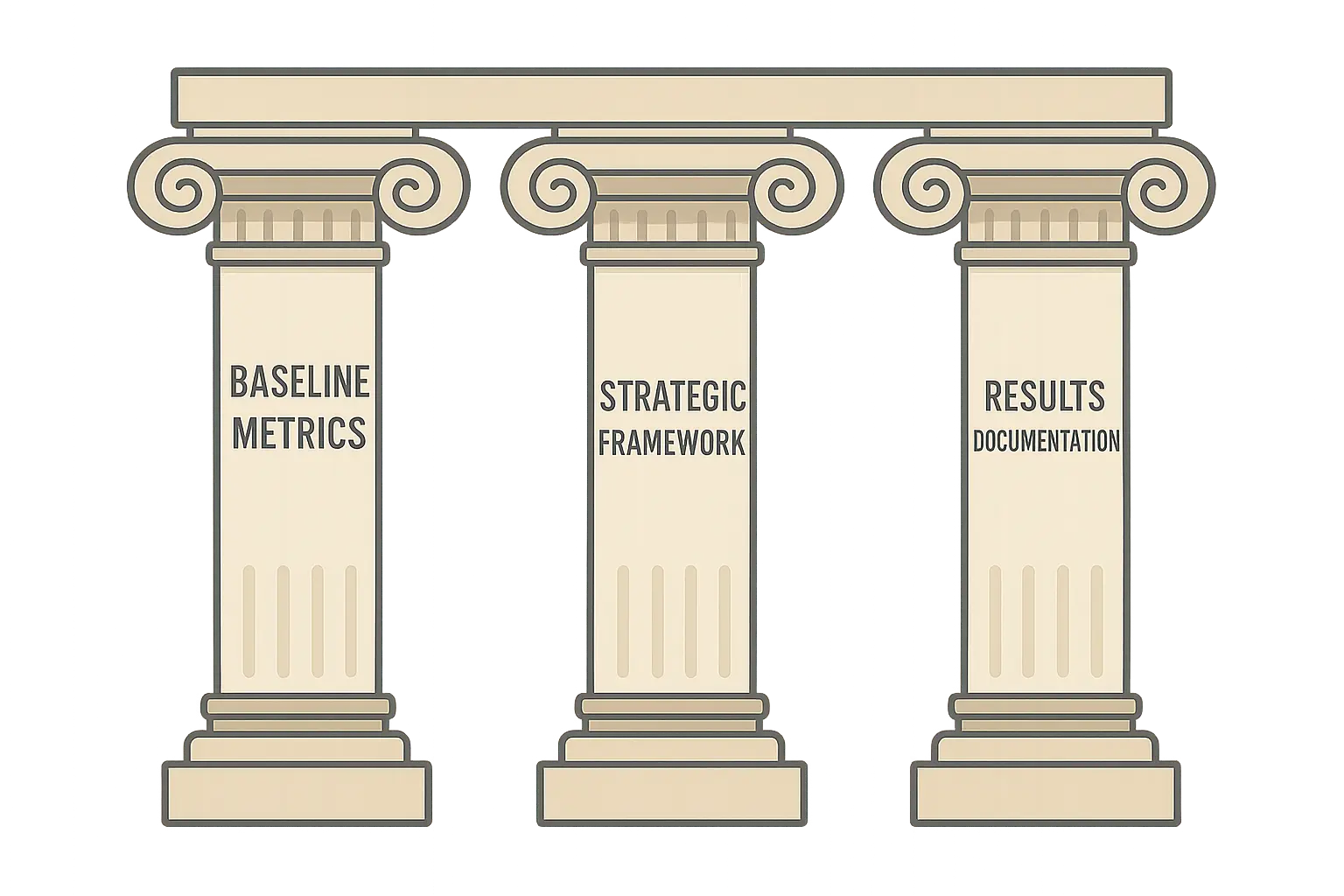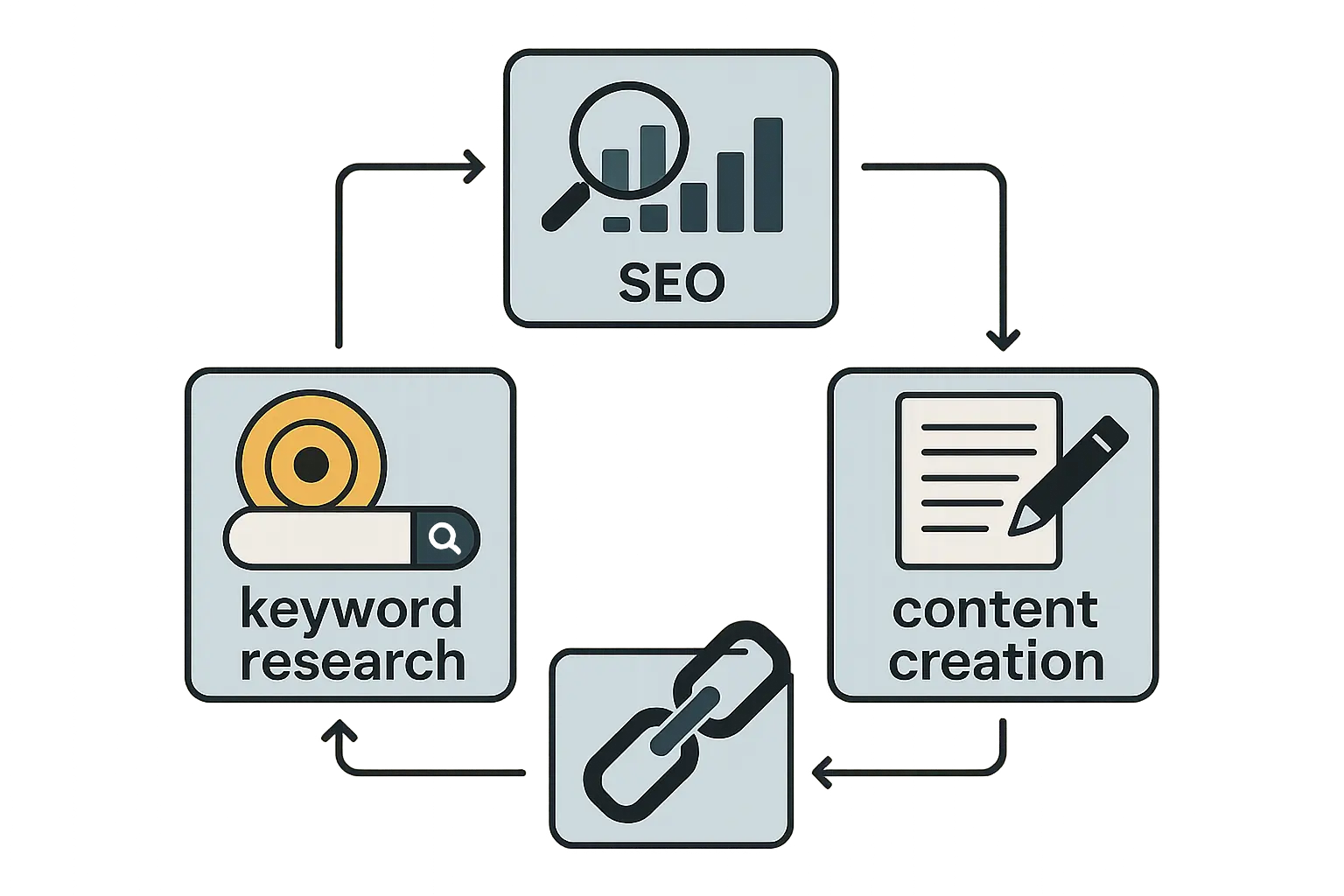
Table of Contents
-
Understanding Ahrefs Case Study Analysis
-
Strategic Implementation Frameworks
-
Performance Measurement and Optimization
-
Practical Application and Replication
TL;DR
-
Ahrefs case studies aren’t just success stories – they’re detailed blueprints showing problem identification, strategic frameworks, and results with real data validation
-
The wins that actually matter focus on keyword gap analysis, search intent mapping, and content clusters (not just throwing keywords at pages and hoping for the best)
-
You can’t just track rankings anymore – you need attribution modeling, cohort analysis, and metrics that actually connect to revenue
-
Want to replicate these results? You’ll need proper resource planning, realistic timelines, and a game plan for when competitors start fighting back
-
Different industries need completely different approaches – what works for e-commerce will crash and burn for B2B
Understanding Ahrefs Case Study Analysis
Look, I’ll be honest – I’ve probably spent way too many late nights diving deep into Ahrefs case studies. We’re talking 3 AM, coffee-fueled deep dives where I’m trying to figure out what separates the campaigns that actually work from the ones that just sound impressive in blog posts.
Here’s what hit me after going through dozens of these: they aren’t just random success stories. They’re actually showing you exactly how real businesses solved real problems and got results you can measure. But here’s the kicker – there’s a sobering reality check buried in the data.
Brace yourself for this one: “96.55% of all pages in our index get zero traffic from Google” according to Ahrefs’ study of 14 billion pages. Yeah, you read that right. Which makes the documented wins in these case studies way more valuable for understanding what separates success from the digital graveyard where most content goes to die.
Every case study that’s actually worth your time (and trust me, I’ve read plenty that aren’t) comes down to three things that separate the real deal from the marketing BS everyone else is peddling. First, they show you exactly where things stood before any changes were made – no cherry-picked starting points. Second, they walk you through the strategic framework they used to tackle specific problems. Third, they give you comprehensive results with proper attribution so you can see what actually moved the needle.
What makes these case studies honestly refreshing in a world full of surface-level content is their commitment to transparency. You’ll find detailed explanations of methodologies, tool usage, and the thought processes that led to success. This level of detail means you can understand not just what worked, but why it worked and how you might adapt similar strategies without just copying and pasting.

Breaking Down What Makes Case Studies Actually Useful
The anatomy of effective Ahrefs case studies reveals a systematic approach that transforms those overwhelming SEO challenges into manageable, step-by-step solutions. Each piece serves a specific purpose in building a story that other professionals can actually learn from and potentially replicate (without losing their minds in the process).
Every worthwhile case study starts with a problem that makes you go “Oh crap, I’ve been there.” Whether it’s watching organic traffic tank, seeing competitors crush you in rankings, or realizing your SEO strategy has been about as effective as a chocolate teapot – the initial challenge needs to feel real. The baseline metrics aren’t just random numbers thrown around to look impressive – they’re the foundation for measuring everything that happens next.
The strategic framework section? That’s where the real learning happens. This is where you discover how Ahrefs tools were actually used to develop solutions that work. I’ve noticed the best case studies don’t just mention using keyword research or competitor analysis – they show you specific screenshots, explain their decision-making process, and reveal the thought patterns behind strategic choices. It’s like getting inside the head of someone who actually knows what they’re doing.
Results documentation is what separates amateur case studies from the ones that’ll actually teach you something. Comprehensive tracking using multiple Ahrefs metrics creates clear cause-and-effect relationships between what was implemented and what improved. The most convincing case studies don’t just show that traffic increased – they show you exactly which strategies contributed to specific improvements.
Here’s a perfect example that blew my mind: Wise achieved 6.4M monthly search visits through strategic content positioning. Instead of going head-to-head with financial giants on broad terms (which would’ve been like bringing a knife to a gunfight), they identified specific user intent gaps around international payment scenarios. They created detailed guides for country-specific transfer processes that larger competitors completely overlooked. This targeted approach allowed them to build authority in underserved niches before expanding to more competitive keywords. Brilliant stuff.
Getting to the Root of Real Problems
Problem identification in Ahrefs case studies goes way beyond surface-level issues to uncover the underlying factors that created the mess in the first place. This deeper analysis is what makes the solutions more robust and the results actually stick around.
The most insightful case studies I’ve analyzed start with problems that have multiple layers. Sure, organic traffic might be tanking, but why? Is it algorithm updates, increased competition, technical issues that nobody noticed, or content that’s about as relevant as last year’s iPhone? The baseline metrics need to capture not just current performance but the trends and patterns that led to the current dumpster fire.
Establishing proper baselines requires looking at data from multiple time periods. Here’s where most people screw up (myself included, at first) – seasonal fluctuations can make a three-month decline look catastrophic when it’s actually normal for that industry. The best case studies account for these variables and establish baselines that reflect true performance rather than temporary dips or spikes that send everyone into panic mode.
How Strategy Actually Gets Implemented
Strategic framework implementation reveals the practical side of SEO theory – basically, how to stop talking about doing SEO and actually do it. This section bridges the gap between knowing what to do and actually doing it effectively without wanting to throw your laptop out the window.
The methodology sections that’ll actually teach you something go beyond listing which tools they used. They explain the sequence of actions, the reasoning behind each decision, and how different Ahrefs features work together to create strategies that don’t fall apart at the first sign of competition. Keyword research isn’t just about finding high-volume terms – it’s about understanding search intent, competitive landscapes, and content gaps that you can actually fill.
Competitor analysis becomes way more sophisticated when you see how experienced SEOs use Ahrefs to identify not just what competitors are doing, but what they’re missing. Content gap identification isn’t just about finding keywords your competitors rank for that you don’t – it’s about understanding why those gaps exist and whether filling them actually aligns with your business goals (spoiler alert: sometimes it doesn’t).
Case Study Implementation Checklist:
-
Establish baseline metrics across multiple time periods (boring but crucial)
-
Document seasonal patterns and industry trends
-
Identify primary and secondary problems affecting performance
-
Map competitor landscape and positioning
-
Define success metrics and attribution methods
-
Create timeline with realistic milestone expectations (emphasis on realistic)
-
Plan resource allocation for each implementation phase
Proving What Actually Worked
Results documentation and attribution represent the most critical aspect of credible case studies – basically, transforming “we did some stuff and things got better” into actual proof that specific strategies produce measurable outcomes.
The case studies that have taught me the most don’t just show improved rankings or increased traffic. They demonstrate clear connections between specific actions and specific results. When organic traffic increases by 150%, which content pieces actually drove that growth? Which keywords moved from page three obscurity to page one glory? How did user engagement metrics change alongside traffic improvements? This stuff matters.
Attribution becomes a real headache when multiple strategies are running simultaneously. The most thorough case studies break down results by individual tactics, showing which elements of the overall strategy contributed most significantly to success. This granular analysis helps you understand which aspects of a strategy are absolutely essential versus which are nice-to-have additions that might not be worth your time.
Here’s a reality check about proving SEO impact: link building campaigns often require massive effort for modest results. Ahrefs’ own link building case study showed they “sent 515 emails and got 36 backlinks from 32 websites”, demonstrating a 5.71% conversion rate. That required systematic outreach and careful prospect vetting to achieve anything meaningful. So yeah, this stuff takes work.
This level of detailed measurement and attribution aligns perfectly with the comprehensive tracking capabilities we explore in our SEO ROI calculator guide, which helps you actually quantify the business impact of these documented results.
Making Sure the Data Actually Means Something
Data collection and verification methods in Ahrefs case studies establish credibility through processes that eliminate bias and account for all the external factors that could mess with your results. This methodological approach is what separates legitimate case studies from marketing materials disguised as research.
Single-source data can be misleading as hell, which is why the most credible case studies cross-reference Ahrefs metrics with Google Analytics, Search Console, and other platforms. This multi-source validation helps identify discrepancies and provides a more complete picture of what’s actually happening (versus what you hope is happening).
The verification process also needs to account for factors beyond the strategies you implemented. Algorithm updates, seasonal changes, and broader market shifts can all mess with SEO performance. Case studies that acknowledge and account for these variables provide way more reliable insights about what actually drove the results versus what just happened to coincide with them.
Why You Need Multiple Data Sources
Multi-source data validation prevents the tunnel vision that comes from relying on a single analytics platform. Here’s the thing – if you’re only looking at one data source, you’re basically flying blind. I learned this the hard way when Ahrefs showed my rankings skyrocketing, but my actual traffic? Crickets.
I’ve seen case studies where Ahrefs showed significant ranking improvements, but Google Analytics revealed that the increased traffic wasn’t converting worth a damn. Others showed traffic increases in Ahrefs that didn’t match Search Console data due to different tracking methodologies. Cross-referencing multiple sources reveals these discrepancies and gives you a more accurate picture of actual performance.
The validation process isn’t just about confirming that numbers match across platforms. Different tools measure different aspects of SEO performance, and combining these perspectives creates a more complete understanding of what’s actually happening. Ahrefs might show keyword ranking improvements while Google Analytics reveals user behavior changes and Search Console provides technical performance insights that explain the why behind the what.
Recent developments in AI content creation add another layer to data validation requirements. “86.5% of top-ranking pages surveyed contained some AI-generated content” according to eMarketer’s analysis of Ahrefs research. This suggests that how you create content might be less important than whether it’s actually good when measuring SEO success.
|
Data Source |
Primary Metrics |
Validation Purpose |
Common Discrepancies |
|---|---|---|---|
|
Ahrefs |
Rankings, backlinks, organic traffic estimates |
Competitive analysis, keyword tracking |
May overestimate traffic, doesn’t track conversions |
|
Google Analytics |
Sessions, conversions, user behavior |
Business impact measurement |
Attribution gaps, sampling issues |
|
Search Console |
Impressions, clicks, CTR, technical issues |
Direct Google data validation |
Limited historical data, query filtering |
|
Third-party Tools |
Domain authority, social signals, technical audits |
Comprehensive performance view |
Varying methodologies, update frequencies |
Accounting for Things You Can’t Control
Timeline considerations and seasonality factors represent external variables that can significantly impact SEO performance. You need to distinguish between results driven by your brilliant strategies versus natural fluctuations or market changes that would’ve happened anyway.
Seasonal businesses face unique challenges when documenting SEO improvements. A 200% traffic increase during peak season might look impressive, but it’s meaningless without comparing it to the same period in previous years. The most reliable case studies normalize for seasonal patterns and show improvements relative to expected performance rather than absolute numbers that might be deceiving.
Algorithm updates can completely change the SEO landscape during a case study period. Google’s core updates, in particular, can cause ranking fluctuations that have absolutely nothing to do with the strategies being implemented. Credible case studies acknowledge when major algorithm changes occurred and analyze whether results were influenced by these updates or driven by the documented strategies.

How Different Industries Need Different Approaches
Industry-specific applications demonstrate that successful SEO strategies must be tailored to the unique challenges, user behaviors, and competitive landscapes that characterize different business sectors. What works brilliantly for e-commerce might crash and burn spectacularly for B2B services.
The case studies that have completely changed how I think about SEO show how the same Ahrefs tools get used in totally different ways depending on industry context. E-commerce sites obsess over product page optimization and local SEO, while B2B companies focus on thought leadership content and those painfully long sales cycles.
Understanding these industry differences helps you identify which case studies are actually relevant to your situation. A local restaurant’s SEO strategy won’t translate directly to a SaaS company, even if both achieved impressive results using similar Ahrefs features. Context matters more than most people realize.
E-commerce SEO Gets Complicated Fast
E-commerce SEO strategies revealed in Ahrefs case studies focus on product page optimization, category structure improvements, and local SEO implementations that address the unique challenges of retail businesses competing in crowded online marketplaces where everyone’s fighting for the same customers.
Product page optimization goes way beyond basic keyword stuffing. The most successful e-commerce case studies show how to optimize for product-specific search intent, handle inventory fluctuations without losing your mind, and create category structures that support both user navigation and search engine crawling. Technical SEO becomes particularly important when you’re dealing with thousands of product pages that all need to work perfectly.
Local SEO implementation for retail businesses involves way more than just setting up Google My Business and calling it a day. Case studies reveal strategies for handling multiple locations, managing inventory-based local searches, and creating location-specific content that drives both online and in-store traffic.
Here’s a perfect example: Carwow’s success in achieving 2.6M monthly search visits worth $3.5M demonstrates sophisticated e-commerce SEO execution. They created detailed car review content that captured both research-phase and purchase-intent searches, building topical authority in automotive categories while maintaining strong commercial conversion paths. Their strategy combined informational content marketing with transactional page optimization, creating multiple entry points for users at different stages of the buying journey. Smart approach.
B2B Content Marketing Requires Patience
B2B content marketing approaches documented in Ahrefs case studies emphasize long-form content strategies, thought leadership positioning, and lead generation through organic search channels that align with extended sales cycles and complex decision-making processes. Translation: everything takes forever, but the payoff can be massive.
The B2B case studies that have taught me the most show how to create content that serves multiple stages of the buyer’s journey without boring people to death. Early-stage awareness content targets broad industry topics, while consideration-stage content addresses specific pain points and solution comparisons. Decision-stage content focuses on implementation details and ROI considerations that help close deals.
Thought leadership positioning requires a different approach to keyword targeting. Instead of focusing solely on high-volume commercial terms, successful B2B strategies target industry-specific topics where expertise can be demonstrated. This approach builds authority over time and attracts qualified leads who are researching solutions rather than just browsing around killing time.
The content ideation process for B2B campaigns often benefits from systematic approaches outlined in our guide on generating high-impact blog topics, which complements the strategic frameworks documented in successful B2B case studies.
Local Business Optimization Has Its Own Rules
Local business optimization techniques shown in Ahrefs case studies focus on geographic targeting, local keyword strategies, and reputation management techniques specifically designed for location-based services competing in defined geographic markets where proximity often trumps everything else.
Geographic targeting becomes complex when businesses serve multiple locations or have service areas that cross city boundaries. The most effective case studies show how to optimize for “near me” searches, handle location-specific content creation, and manage local citation consistency across multiple directories and platforms without losing your sanity.
Local keyword strategies require understanding how people actually search for local services. “Best pizza near me” and “pizza delivery downtown” represent different search intents that require different optimization approaches. Successful local SEO case studies demonstrate how to identify and target these intent variations effectively.
Local SEO Optimization Template:
-
Geographic Research Phase
-
Map service areas and competitor locations
-
Identify location-specific keyword variations
-
Analyze local search volume and competition
-
-
Content Localization Strategy
-
Create location-specific landing pages
-
Develop local event and news content
-
Build community-focused resource pages
-
-
Citation and Directory Management
-
Audit existing business listings
-
Ensure NAP consistency across platforms
-
Target industry-specific directories
-
Strategic Implementation Frameworks
Strategic implementation frameworks revealed in Ahrefs case studies provide step-by-step processes that can be adapted across different business contexts. Look, all this strategy talk is useless if you can’t actually put it into practice. Here’s how this stuff actually works in the real world.
The frameworks that have completely changed my approach treat SEO as an ongoing system rather than a one-time project you can check off your list. This means establishing processes for regular performance review, hypothesis testing, and strategic adjustment based on actual results and market changes (because the market never stops changing).
What makes these frameworks particularly valuable is their adaptability. While specific tactics might vary by industry or business size, the underlying processes remain consistent. Understanding these frameworks helps you develop your own systematic approach rather than just throwing random SEO tactics at the wall and seeing what sticks.

Finding Opportunities Your Competitors Miss
Keyword research and competitive analysis using Ahrefs tools reveals opportunities that competitors either haven’t discovered or haven’t been able to capitalize on effectively. Translation: there’s still gold in them hills if you know where to look.
The competitive analysis techniques that have blown my mind go beyond identifying what competitors rank for. They focus on understanding why competitors succeed with certain keywords and fail miserably with others. This deeper analysis reveals opportunities where you might have advantages in content quality, user experience, or technical implementation.
Advanced keyword gap analysis isn’t just about finding missing keywords – it’s about understanding the strategic implications of those gaps. Some gaps exist because competitors haven’t recognized the opportunity yet. Others exist because the keywords don’t align with competitor business models. Figuring out which type of gap you’re looking at determines whether it’s actually worth pursuing.
Advanced Keyword Gap Analysis That Actually Works
Advanced keyword gap analysis using Ahrefs goes beyond simple competitor comparison to identify strategic opportunities where your content, expertise, or business model provides natural advantages over competing websites.
The gap analysis process starts with identifying your true competitors. These aren’t necessarily your business competitors – they’re the websites that compete with you for the same search results. Picture this: your neighborhood pizza joint isn’t just competing with the Italian place down the street – they’re going head-to-head with Food Network and Bon Appétit for searches like “best pizza dough recipe.”
Once you’ve identified search competitors, the analysis focuses on understanding why gaps exist. Are competitors missing these keywords because they lack expertise in that area? Do the keywords not align with their business model? Are there technical barriers preventing them from ranking? Understanding the reasons behind gaps helps you evaluate whether you can realistically fill them.
The most valuable gaps are those where you have natural advantages. If you’re a financial advisor competing with general finance websites, you might find gaps in local financial planning topics where your expertise and location give you credibility advantages that larger sites can’t match.
Here’s a reality check about targeting the right opportunities: according to Ahrefs’ comprehensive study, “only 1.94% get between one and ten monthly visits” from organic search. This highlights how critical it is to identify keyword gaps that actually have traffic potential rather than pursuing keywords that won’t drive meaningful results.
This strategic approach to competitive analysis complements the tool comparison insights found in our Ahrefs vs SEMrush comparison, which helps determine which platform provides the most accurate data for identifying these crucial opportunities.
Understanding What People Actually Want
Search intent mapping involves analyzing SERP features and user behavior patterns to align content creation with actual user needs rather than just targeting keywords based on search volume or difficulty scores. Basically, stop guessing what people want and start looking at what they’re actually searching for.
Search intent analysis requires looking beyond the keyword itself to understand what users are actually trying to accomplish. “Best CRM software” might seem straightforward, but SERP analysis might reveal that users are looking for comparison articles, feature breakdowns, or implementation guides rather than direct sales pages that try to sell them something immediately.
SERP feature analysis provides clues about user intent that keyword research alone can’t reveal. Featured snippets suggest users want quick answers. Video results indicate visual content performs well. Local pack results show geographic intent. Understanding these signals helps you create content that matches what users actually want to find (revolutionary concept, right?).
User behavior patterns extend beyond initial search queries. People searching for “how to install WordPress” might follow up with searches for themes, plugins, or troubleshooting guides. Mapping these behavior patterns helps you create content clusters that serve complete user journeys rather than individual search queries that leave people hanging.

Building Content That Actually Connects
Content strategy development transforms keyword research insights into actionable content plans that drive organic growth by addressing user needs systematically rather than creating isolated pieces that compete with each other for rankings (which is about as productive as it sounds).
The content strategies that have impressed me most treat individual pieces as components of larger systems rather than standalone assets. Each piece serves a specific purpose within the overall strategy, whether that’s capturing top-of-funnel awareness, nurturing consideration-stage prospects, or supporting decision-making processes.
Content planning becomes way more sophisticated when you understand how different pieces work together to build topical authority. Instead of creating random blog posts about industry topics, successful strategies develop comprehensive coverage of specific subject areas that demonstrate expertise and serve complete user journeys.
Creating Content Clusters That Build Authority
Content cluster creation involves building interconnected content pieces that support primary target keywords while capturing long-tail variations. It’s like creating a web of related content that demonstrates you actually know what you’re talking about.
The cluster approach starts with identifying pillar topics that align with your business expertise and target audience needs. These aren’t just high-volume keywords – they’re comprehensive topics where you can create definitive resources that serve as the foundation for related content pieces.
Supporting content pieces address specific aspects of the pillar topic in greater detail. If your pillar content covers “email marketing strategy,” supporting pieces might address list building, automation workflows, deliverability optimization, and performance measurement. Each supporting piece links back to the pillar content and to related supporting pieces, creating a network of interconnected value.
Internal linking structure becomes critical for cluster success. The connections between pieces need to make sense from both user and search engine perspectives. Users should be able to navigate naturally from general topics to specific details, while search engines should understand the topical relationships between different pieces.
Here’s a perfect example that blew my mind: Grammarly’s achievement of over 22M monthly search visits exemplifies masterful content clustering. They built comprehensive coverage around writing improvement topics, creating pillar content about grammar fundamentals while developing supporting pieces for specific writing scenarios like business emails, academic papers, and creative writing. Each piece reinforces their expertise while serving different user intents within the broader writing improvement journey.
Measuring What Actually Matters
Performance tracking and iteration involves establishing meaningful KPIs and feedback loops that enable continuous optimization based on actual performance data rather than assumptions about what should work (because assumptions are usually wrong).
The tracking systems that have taught me the most go beyond vanity metrics like page views or social shares that make you feel good but don’t pay the bills. They focus on metrics that connect to business outcomes: lead generation, customer acquisition, revenue attribution, and user engagement patterns that indicate content quality and relevance.
KPI selection depends on content purpose and business model. Blog posts designed for awareness might be measured by organic traffic growth and social engagement. Lead magnets should be evaluated based on conversion rates and lead quality. Product-focused content needs to be assessed based on its impact on sales and customer acquisition costs.
Feedback loops enable continuous improvement by connecting performance data to content optimization decisions. If certain topics consistently generate high engagement but low conversions, that suggests a need for better calls-to-action or more targeted content. If technical topics perform well with organic traffic but poorly with social sharing, that indicates audience preferences that should inform future content planning.
Content Performance Measurement Template:
-
Traffic Metrics: Organic sessions, page views, time on page, bounce rate
-
Engagement Indicators: Comments, social shares, backlink acquisition, return visitors
-
Conversion Tracking: Lead generation, email signups, demo requests, sales attribution
-
Authority Signals: Keyword ranking improvements, featured snippet captures, brand mention increases
-
Competitive Position: Share of voice, ranking position changes, content gap closure
Building Links That Actually Stick
Backlink acquisition strategies documented in case studies show systematic approaches to earning high-quality links through content marketing, digital PR, and relationship building rather than relying on manipulative tactics that risk penalties and make you look desperate.
The link building approaches that have influenced my thinking focus on creating genuine value for other websites and their audiences. This means developing content, resources, or insights that other sites want to reference because it enhances their own content rather than because they’re doing you a favor.
Content-based link building starts with understanding what types of content naturally attract links in your industry. Original research, comprehensive guides, and unique tools or resources tend to earn links because they provide value that other content creators want to reference. The key is creating something genuinely useful rather than just hoping people will link to promotional content.
Digital PR extends beyond traditional press releases to include thought leadership positioning, expert commentary on industry trends, and participation in relevant conversations where your expertise adds value. This approach builds relationships with journalists, bloggers, and industry influencers who might reference your work in future content.
Relationship building requires genuine engagement with your industry community rather than transactional link requests that make everyone cringe. Contributing valuable insights to industry discussions, sharing others’ content when it’s genuinely useful, and offering expertise when people have questions creates a foundation for natural link opportunities.
The evolving landscape of content creation adds complexity to link building strategies. Recent research showing “no correlation between AI content and Google rankings” according to Search Engine Journal’s coverage of Ahrefs findings suggests that link building success may depend more on content value and relationship quality than the specific methods used to create the content.

Performance Measurement and Optimization
Performance measurement and optimization in Ahrefs case studies demonstrates how to move beyond vanity metrics to focus on business-impacting KPIs and continuous improvement processes that drive long-term SEO success. Let’s be real about what actually matters here.
The measurement approaches that have shaped my understanding focus on connecting SEO improvements to actual business outcomes. Rankings and traffic increases are meaningless if they don’t translate to leads, sales, or other business objectives that keep the lights on. The most valuable case studies show how to establish these connections and use them to guide optimization decisions.
Continuous improvement becomes possible when you have systems that identify what’s working, what isn’t, and why. This requires more sophisticated analytics than most people implement, but the insights gained make the extra effort worthwhile (trust me on this one).
Connecting SEO to Business Results
Advanced analytics integration combines Ahrefs data with broader business intelligence systems to demonstrate ROI and inform strategic decisions. Here’s where most people screw up – they track everything except what actually matters to the business.
The analytics integration that has taught me the most goes beyond basic Google Analytics setup to include customer journey tracking, revenue attribution, and lifetime value analysis. This comprehensive approach reveals how SEO contributes to business growth rather than just generating website traffic that doesn’t convert.
Attribution modeling becomes a real headache when customers interact with multiple touchpoints before converting. Someone might discover your business through organic search, return via social media, and finally convert through email marketing. Understanding these multi-touch journeys helps you properly credit SEO’s role in customer acquisition.
|
Attribution Model |
Best For |
Advantages |
Limitations |
|---|---|---|---|
|
First-Click |
Awareness campaigns |
Clear credit to discovery channels |
Ignores nurturing touchpoints |
|
Last-Click |
Direct response |
Simple implementation |
Undervalues top-funnel efforts |
|
Linear |
Balanced view |
Equal credit to all touchpoints |
May overweight minor interactions |
|
Time-Decay |
Long sales cycles |
Emphasizes recent interactions |
Complex to implement |
|
Position-Based |
Multi-stage funnels |
Highlights discovery and conversion |
Requires custom configuration |
Proving SEO Actually Drives Revenue
Attribution modeling for SEO involves connecting organic search improvements to actual business outcomes like revenue, leads, and customer acquisition costs. Basically, proving that all this SEO work isn’t just an expensive hobby.
Revenue attribution requires tracking systems that connect organic search visitors to actual purchases or lead conversions. This means implementing proper UTM parameters, setting up goal tracking, and often integrating analytics with CRM systems to follow leads through the entire sales process (which can get messy fast).
Customer acquisition cost analysis helps justify SEO investments by comparing the cost of acquiring customers through organic search versus paid channels. When you can show that SEO-acquired customers have lower acquisition costs and higher lifetime values, it becomes way easier to secure resources for continued optimization efforts.
The most sophisticated attribution models account for the fact that SEO often influences customers who convert through other channels. Someone might research your company through organic search, then convert via direct traffic or paid ads. Proper attribution gives SEO credit for its role in the customer journey even when it’s not the final touchpoint.
Understanding Long-Term User Behavior
Cohort analysis and user behavior tracking reveals how SEO improvements affect user engagement, retention, and conversion paths over extended time periods. This stuff provides insights into content quality and user satisfaction that go way beyond initial traffic metrics.
Cohort analysis groups users based on when they first visited your site and tracks their behavior over time. This approach reveals whether SEO improvements are attracting higher-quality visitors who engage more deeply with your content and return more frequently (which is what you actually want).
User behavior patterns provide insights into content effectiveness that traffic metrics alone can’t reveal. High bounce rates might indicate that your content doesn’t match search intent, while long session durations and multiple page views suggest that visitors find your content valuable and engaging.
Conversion path analysis shows how organic search visitors navigate through your site before converting. Understanding these paths helps you optimize the user experience and identify content gaps that might be preventing conversions.

Making Improvements That Actually Last
Continuous improvement methodologies revealed in long-term case studies show how initial SEO successes are built upon and scaled through systematic testing, optimization, and adaptation to changing search landscapes. Because guess what? The work never stops.
The improvement processes that have influenced my approach treat SEO as an ongoing optimization challenge rather than a one-time implementation project you can finish and forget about. This means establishing systems for regular performance review, hypothesis testing, and strategic adjustment based on results and market changes.
Systematic testing helps you understand which optimization efforts produce the best results for your specific situation. What works brilliantly for one website might crash and burn for another, even in the same industry. Testing helps you identify the tactics that work best for your audience and business model.
Testing Your Way to Better Results
A/B testing for SEO elements involves systematic testing of title tags, meta descriptions, and content structures to optimize click-through rates and user engagement while maintaining or improving search rankings. Fair warning: this approach requires way more patience than most people think.
SEO A/B testing requires careful methodology to ensure that results are statistically significant and not influenced by external factors like algorithm updates or seasonal changes. This means testing one element at a time, running tests for sufficient duration, and accounting for variables that might skew results.
Title tag testing can significantly impact click-through rates from search results. Testing different approaches – emotional triggers, benefit-focused headlines, question formats – helps you understand what resonates with your specific audience and improves organic traffic even without ranking improvements.
Content structure testing reveals how different formatting approaches affect user engagement and search performance. Testing longer versus shorter content, different heading structures, or various call-to-action placements helps optimize for both user experience and search engine preferences.
SEO Testing Framework:
-
Hypothesis Formation
-
Identify specific element to test
-
Define expected outcome
-
Establish success metrics
-
-
Test Design
-
Create control and variant versions
-
Determine sample size requirements
-
Set testing duration
-
-
Implementation
-
Deploy tests systematically
-
Monitor for external factors
-
Track relevant metrics
-
-
Analysis and Action
-
Calculate statistical significance
-
Document learnings
-
Implement winning variations
-
Staying Strong When Google Changes Everything
Algorithm update response strategies help maintain consistent performance growth even when Google makes significant changes to ranking factors. Because let’s face it – Google’s going to keep changing things whether we like it or not.
Algorithm update preparation involves building SEO strategies that focus on fundamental user value rather than exploiting specific ranking factors. When your content genuinely serves user needs and your technical implementation follows best practices, algorithm updates are less likely to cause significant negative impacts.
Recovery strategies for when updates do cause problems focus on identifying what changed and adapting accordingly. This requires analyzing which pages lost rankings, understanding what those pages had in common, and making adjustments that align with the new algorithm preferences.
The most resilient SEO strategies diversify across multiple ranking factors rather than relying heavily on any single approach. This means balancing content quality, technical optimization, user experience, and authority building so that changes to any single factor don’t completely devastate overall performance.

Practical Application and Replication
Practical application and replication involves translating case study insights into actionable plans for your own SEO initiatives. Here’s the thing – direct replication rarely works, but the underlying principles can be adapted effectively if you know what you’re doing.
The application process that has worked best for me starts with identifying which case study elements are most relevant to my situation and which require serious adaptation for different business models, industries, or resource levels. You can’t just copy and paste someone else’s strategy and expect it to work.
Success prediction becomes way more accurate when you understand the factors that contributed to case study results and how those factors apply to your specific situation. This helps set realistic expectations and identify potential obstacles before they turn into major headaches.
Planning Resources and Setting Expectations
Resource planning and budget allocation based on case study insights helps determine the investment requirements needed to replicate successful SEO strategies. Let’s be real about what this actually costs in time and money.
The resource planning that has prevented most of my SEO disappointments involves honestly assessing what’s required to execute strategies effectively rather than hoping that half-hearted implementation will produce proportional results. SEO strategies often require minimum viable implementations to produce meaningful results – there’s no participation trophy here.
Budget allocation needs to account for both direct costs (tools, content creation, technical implementation) and opportunity costs (time spent on SEO versus other marketing activities that might deliver faster results). Understanding these full costs helps you make informed decisions about which strategies to pursue and which to postpone until you have proper resources.
Building the Right Team for SEO Success
Team structure and skill requirements based on case study analysis help identify the human resources needed to execute successful SEO strategies. If you’re a one-person show, you’re going to need to pick your battles carefully.
The team structures that have produced the best results combine technical SEO expertise, content creation skills, and strategic thinking rather than expecting one person to handle all aspects of SEO effectively. Different strategies require different skill combinations, and understanding these requirements helps you build appropriate teams or know when to outsource.
Skill development becomes important when you can’t hire all the expertise you need (which is most of us). Identifying which skills are most critical for your specific strategy helps you prioritize training and development efforts. Some skills can be learned relatively quickly, while others require significant experience to master.
External expertise might be necessary for specialized aspects of SEO implementation. Technical audits, advanced analytics setup, or industry-specific content creation might require consultants or agencies even when you have internal SEO capabilities.
Here’s a reality check about the complexity of modern SEO: based on Ahrefs’ detailed case study, achieving meaningful link building results required sending “515 emails and got 36 backlinks from 32 websites” for a 5.71% conversion rate. That’s substantial human resources needed for effective outreach campaigns and highlights the importance of having dedicated team members for different SEO functions.
Choosing the Right Tools for Your Situation
Tool stack optimization involves determining which Ahrefs features and complementary tools are essential for replicating case study successes in different business contexts. Don’t kid yourself into thinking you need every tool under the sun.
Tool selection should align with your specific strategy requirements rather than trying to replicate exactly what successful case studies used. A local business might not need enterprise-level competitive analysis tools, while a large e-commerce site might require more sophisticated technical SEO platforms.
Ahrefs feature prioritization helps you get maximum value from your subscription by focusing on the capabilities that matter most for your strategy. Keyword research and competitor analysis might be priorities for content-focused strategies, while site audit and rank tracking might be more important for technical optimization efforts.
Complementary tools fill gaps that Ahrefs doesn’t address directly. Google Analytics and Search Console provide essential performance data, while tools for technical SEO, local optimization, or content creation might be necessary depending on your strategy focus.
For businesses evaluating their tool stack options, our comprehensive SEO content tools review provides detailed comparisons that complement the insights gained from analyzing successful case study implementations.

Setting Realistic Timelines and Milestones
Timeline and milestone planning based on case study analysis helps set realistic expectations for SEO results while accounting for industry-specific factors, competitive landscapes, and implementation complexity. In my experience, you need at least 90 days before you can tell if this stuff is actually working.
Timeline expectations need to account for the fact that SEO results compound over time rather than appearing immediately like some kind of magic trick. Early improvements might be modest, with more significant gains appearing after several months of consistent implementation. Understanding this progression helps maintain motivation during slower initial periods.
Milestone planning breaks long-term SEO goals into shorter-term achievements that can be measured and celebrated along the way. This might include technical implementation milestones, content creation targets, or incremental ranking improvements that indicate progress toward larger objectives.
Industry factors significantly influence timeline expectations. Competitive industries require longer timeframes to see significant results, while less competitive niches might show improvements more quickly. Understanding your competitive landscape helps set appropriate expectations and prevents premature panic.
SEO Timeline Planning Template:
-
Month 1-2: Technical audit completion, baseline metric establishment, competitor analysis
-
Month 3-4: Content strategy development, initial content creation, on-page optimization
-
Month 5-6: Link building campaign launch, content cluster completion, first performance review
-
Month 7-9: Strategy refinement based on data, scaling successful tactics, addressing gaps
-
Month 10-12: Advanced optimization, competitive response planning, ROI measurement
Preparing for Challenges and Competition
Risk management and contingency planning based on case study challenges and failures helps develop robust SEO strategies that can withstand market changes, competitive pressures, and unexpected obstacles that commonly derail optimization efforts.
The risk management approaches that have saved me from major setbacks involve identifying potential failure points before implementing strategies and developing contingency plans for common problems. This proactive approach prevents small issues from becoming major disasters that kill your momentum.
Competitive response planning acknowledges that successful SEO often triggers competitive reactions. When you start ranking well for valuable keywords, competitors might increase their own optimization efforts or target the same opportunities. Preparing for these responses helps maintain strategic advantages.
Staying Ahead When Competitors Fight Back
Competitive response strategies involve preparing for competitor reactions to your SEO improvements and maintaining strategic advantages through continuous innovation, deeper expertise development, and superior user experience delivery.
Competitive monitoring helps you identify when competitors are responding to your SEO success and adjust your strategies accordingly. This might involve expanding into new keyword areas, improving content quality, or developing unique value propositions that are harder to replicate.
Innovation becomes important for maintaining competitive advantages over time. This might involve developing new content formats, exploring emerging search opportunities, or creating unique resources that competitors can’t easily duplicate without significant investment.
The most sustainable competitive advantages come from genuine expertise and superior user experience rather than tactical SEO implementations that can be copied. Building these deeper advantages takes longer but provides more lasting protection against competitive responses.
The Marketing Agency can help you implement these strategies effectively without the trial-and-error process that often accompanies DIY SEO efforts. Their data-driven approach mirrors the rigorous methodology found in the most successful Ahrefs case studies, ensuring that your SEO investments are based on solid evidence rather than guesswork and wishful thinking.
The Marketing Agency’s AI-driven analytics and real-time campaign analysis capabilities mean you can track progress and make adjustments with the same precision demonstrated in top-performing case studies. Instead of waiting months to discover whether your strategy is working, you’ll have continuous insights that enable rapid optimization and course correction when needed.
Ready to transform your SEO results with proven, data-driven strategies? Contact The Marketing Agency today to discover how their systematic approach can help you achieve the kind of measurable success documented in the most compelling Ahrefs case studies.

Final Thoughts
The most valuable insight from analyzing dozens of Ahrefs case studies? Successful SEO isn’t about finding secret tactics or exploiting algorithm loopholes – it’s about implementing systematic, data-driven processes that consistently deliver value to users while building sustainable competitive advantages.
The case studies that have completely changed my approach demonstrate that lasting SEO success comes from understanding your audience deeply, creating genuinely useful content, and continuously optimizing based on performance data rather than assumptions or the latest “guru” advice floating around on Twitter.
Whether you’re just starting with SEO or looking to improve existing efforts that haven’t been delivering, the frameworks and methodologies revealed in these case studies provide proven pathways to measurable results that go way beyond temporary ranking improvements. Bottom line: start with the fundamentals, measure what matters, and be prepared to put in the work consistently over time.



